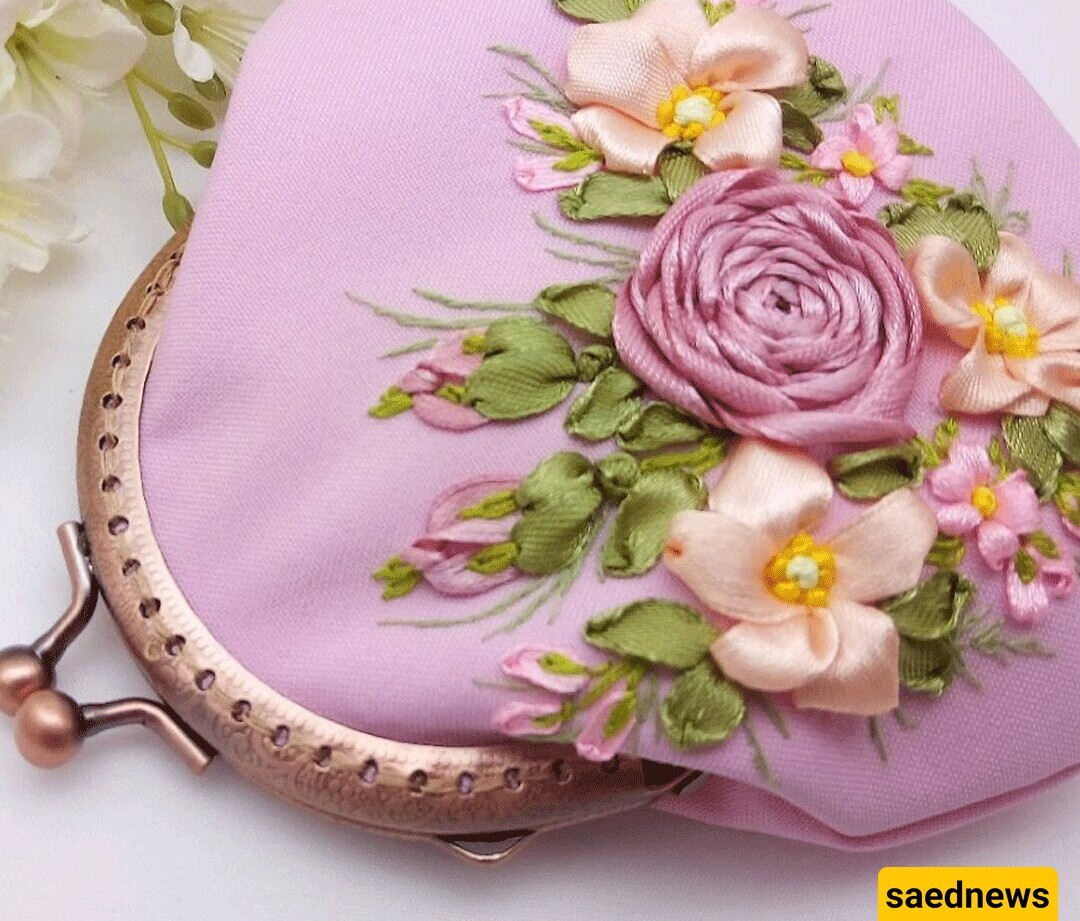In this article, we provide a complete introduction to the art of ribbon embroidery. This art, which originates from France and the Netherlands, does not have a long history in Iran, but due to its beauty and simplicity, it has become one of the best and most attractive handicrafts among Iranian women.

This art is one of the sub-branches of needlework, where by combining various types of fabric, ribbons, and embroidery threads, you can create beautiful works. For this craft, you should use a suitable fabric, such as coarse-weave fabrics like Panama cotton, organza, terry cloth, and velvet. In ribbon embroidery, the needle must pass easily through the fabric; otherwise, you cannot achieve clean work. The colors of the ribbon, fabric, and thread used in ribbon embroidery should be colorfast.
DMC embroidery threads are suitable for ribbon embroidery. You can also use threads such as Omameh, Golabtoon, and Disco. Ribbons come in various sizes, and you should choose narrow or wide ribbons depending on the pattern. Wide and starched ribbons are suitable for large flowers, which are usually sewn on the surface and should not go inside the fabric. Narrow ribbons without starch, in dark and light colors, are the most suitable.
In ribbon embroidery, instead of embroidery thread, ribbons are used. Sometimes a combination of ribbon and embroidery thread, along with decorative beads, creates beautiful designs.
At first, you might think that ribbon embroidery is difficult; however, using ribbon to decorate fabric, decorative items, cushions, bedspreads and quilts, aprons, napkins, and table runners adds a unique beauty to your home. One advantage of ribbon embroidery is that with a few simple stitches, you can cover a larger area in less time using ribbon.

History of Ribbon Embroidery
The history of ribbon embroidery dates back to the 16th century in Europe. French women used ribbon embroidery to adorn their clothes, hats, bags, gloves, and umbrellas. Shortly afterward, English women adopted this art and made it their own. This art has always had its followers and now, due to the existence of intricate and stunning designs and the variety of ribbons and colors, it has become very popular. Once you learn the basic techniques, you can sew beautiful ribbon flowers.

Required Tools for Ribbon Embroidery
Needle
Ribbon
Hoop
Pattern
Ribbon Embroidery Needle
The chenille needle is an essential tool for ribbon embroidery. It has a long, slender eye and a sharp point. The eye of the needle should be large enough to allow the ribbon to pass through without damage or wrinkling. The chenille needle is large and, with its sharp tip, easily passes through thick fabrics.
Types of Ribbon
Ribbon, or ruban in French, is a thin strip made from materials like fabric, metal, or plastic, primarily used for decorative purposes and packaging. Different cultures around the world use ribbon for various decorative and symbolic purposes.
Ribbons come in many types and sizes, and different ribbons are used depending on the design, such as:
Silk Habotai ribbons
Lace ribbons
Edge-embroidered ribbons
Jacquard ribbons
Grosgrain ribbons
Double-sided satin ribbons
Floral ribbons
Organza ribbons
Wired ribbons
Taffeta ribbons
Velvet ribbons
And more
Uses of Ribbon Embroidery
One of the uses of ribbon embroidery is decorating clothes. You can transform your plain clothes into luxurious and special ribbon-embroidered garments using various ribbons. Also, if you want to embellish your tablecloths, sewing ribbon flowers on them can make them unique. Ribbon-embroidered tablecloths are among the most common applications. Ribbon-embroidered prayer rugs are also one of the most attractive designs and, due to their delicacy, are especially favored by brides.

Learning Time
The time required depends on various factors: how much time you dedicate daily to learning, your talent, and whether you take classes or learn on your own. Generally, with about two hours of practice daily, you may need roughly 4 to 8 weeks to reach an intermediate level in ribbon embroidery.

